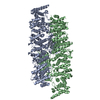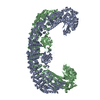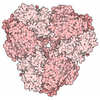+ Open data
Open data
- Basic information
Basic information
| Entry | Database: PDB / ID: 8e2d | |||||||||
|---|---|---|---|---|---|---|---|---|---|---|
| Title | Cryo-EM structure of BIRC6 (consensus) | |||||||||
 Components Components | Baculoviral IAP repeat-containing protein 6 | |||||||||
 Keywords Keywords | LIGASE / Ubiquitin / E3 ligase / Apoptosis / Autophagy / IAP | |||||||||
| Function / homology |  Function and homology information Function and homology informationlabyrinthine layer development / (E3-independent) E2 ubiquitin-conjugating enzyme / ALK mutants bind TKIs / Flemming body / ubiquitin conjugating enzyme activity / microtubule organizing center / cysteine-type endopeptidase inhibitor activity / regulation of cytokinesis / negative regulation of extrinsic apoptotic signaling pathway / trans-Golgi network ...labyrinthine layer development / (E3-independent) E2 ubiquitin-conjugating enzyme / ALK mutants bind TKIs / Flemming body / ubiquitin conjugating enzyme activity / microtubule organizing center / cysteine-type endopeptidase inhibitor activity / regulation of cytokinesis / negative regulation of extrinsic apoptotic signaling pathway / trans-Golgi network / spindle pole / ubiquitin-protein transferase activity / Signaling by ALK fusions and activated point mutants / regulation of cell population proliferation / midbody / cell population proliferation / protein phosphorylation / endosome / protein ubiquitination / cell division / positive regulation of cell population proliferation / apoptotic process / centrosome / negative regulation of apoptotic process / metal ion binding / nucleus / membrane / cytosol Similarity search - Function | |||||||||
| Biological species |  Homo sapiens (human) Homo sapiens (human) | |||||||||
| Method | ELECTRON MICROSCOPY / single particle reconstruction / cryo EM / Resolution: 2.07 Å | |||||||||
 Authors Authors | Hunkeler, M. / Fischer, E.S. | |||||||||
| Funding support |  United States, 2items United States, 2items
| |||||||||
 Citation Citation |  Journal: Science / Year: 2023 Journal: Science / Year: 2023Title: Structures of BIRC6-client complexes provide a mechanism of SMAC-mediated release of caspases. Authors: Moritz Hunkeler / Cyrus Y Jin / Eric S Fischer /  Abstract: Tight regulation of apoptosis is essential for metazoan development and prevents diseases such as cancer and neurodegeneration. Caspase activation is central to apoptosis, and inhibitor of apoptosis ...Tight regulation of apoptosis is essential for metazoan development and prevents diseases such as cancer and neurodegeneration. Caspase activation is central to apoptosis, and inhibitor of apoptosis proteins (IAPs) are the principal actors that restrain caspase activity and are therefore attractive therapeutic targets. IAPs, in turn, are regulated by mitochondria-derived proapoptotic factors such as SMAC and HTRA2. Through a series of cryo-electron microscopy structures of full-length human baculoviral IAP repeat-containing protein 6 (BIRC6) bound to SMAC, caspases, and HTRA2, we provide a molecular understanding for BIRC6-mediated caspase inhibition and its release by SMAC. The architecture of BIRC6, together with near-irreversible binding of SMAC, elucidates how the IAP inhibitor SMAC can effectively control a processive ubiquitin ligase to respond to apoptotic stimuli. | |||||||||
| History |
|
- Structure visualization
Structure visualization
| Structure viewer | Molecule:  Molmil Molmil Jmol/JSmol Jmol/JSmol |
|---|
- Downloads & links
Downloads & links
- Download
Download
| PDBx/mmCIF format |  8e2d.cif.gz 8e2d.cif.gz | 1.5 MB | Display |  PDBx/mmCIF format PDBx/mmCIF format |
|---|---|---|---|---|
| PDB format |  pdb8e2d.ent.gz pdb8e2d.ent.gz | Display |  PDB format PDB format | |
| PDBx/mmJSON format |  8e2d.json.gz 8e2d.json.gz | Tree view |  PDBx/mmJSON format PDBx/mmJSON format | |
| Others |  Other downloads Other downloads |
-Validation report
| Summary document |  8e2d_validation.pdf.gz 8e2d_validation.pdf.gz | 1.3 MB | Display |  wwPDB validaton report wwPDB validaton report |
|---|---|---|---|---|
| Full document |  8e2d_full_validation.pdf.gz 8e2d_full_validation.pdf.gz | 1.4 MB | Display | |
| Data in XML |  8e2d_validation.xml.gz 8e2d_validation.xml.gz | 111.9 KB | Display | |
| Data in CIF |  8e2d_validation.cif.gz 8e2d_validation.cif.gz | 171.8 KB | Display | |
| Arichive directory |  https://data.pdbj.org/pub/pdb/validation_reports/e2/8e2d https://data.pdbj.org/pub/pdb/validation_reports/e2/8e2d ftp://data.pdbj.org/pub/pdb/validation_reports/e2/8e2d ftp://data.pdbj.org/pub/pdb/validation_reports/e2/8e2d | HTTPS FTP |
-Related structure data
| Related structure data |  27832MC  8e2eC  8e2fC  8e2gC  8e2hC  8e2iC  8e2jC  8e2kC C: citing same article ( M: map data used to model this data |
|---|---|
| Similar structure data | Similarity search - Function & homology  F&H Search F&H Search |
- Links
Links
- Assembly
Assembly
| Deposited unit | 
|
|---|---|
| 1 |
|
- Components
Components
| #1: Protein | Mass: 534158.312 Da / Num. of mol.: 2 Source method: isolated from a genetically manipulated source Source: (gene. exp.)  Homo sapiens (human) / Gene: BIRC6, KIAA1289 / Cell line (production host): Expi293 / Production host: Homo sapiens (human) / Gene: BIRC6, KIAA1289 / Cell line (production host): Expi293 / Production host:  Homo sapiens (human) / References: UniProt: Q9NR09, Ligases Homo sapiens (human) / References: UniProt: Q9NR09, Ligases |
|---|
-Experimental details
-Experiment
| Experiment | Method: ELECTRON MICROSCOPY |
|---|---|
| EM experiment | Aggregation state: PARTICLE / 3D reconstruction method: single particle reconstruction |
- Sample preparation
Sample preparation
| Component | Name: Baculoviral IAP repeat-containing protein 6 / Type: COMPLEX / Entity ID: all / Source: RECOMBINANT | ||||||||||||||||||||
|---|---|---|---|---|---|---|---|---|---|---|---|---|---|---|---|---|---|---|---|---|---|
| Molecular weight | Value: 1.067 MDa / Experimental value: NO | ||||||||||||||||||||
| Source (natural) | Organism:  Homo sapiens (human) Homo sapiens (human) | ||||||||||||||||||||
| Source (recombinant) | Organism:  Homo sapiens (human) / Strain: Expi293 Homo sapiens (human) / Strain: Expi293 | ||||||||||||||||||||
| Buffer solution | pH: 7.4 | ||||||||||||||||||||
| Buffer component |
| ||||||||||||||||||||
| Specimen | Conc.: 2 mg/ml / Embedding applied: NO / Shadowing applied: NO / Staining applied: NO / Vitrification applied: YES / Details: added CHAPSO to 0.8 mM | ||||||||||||||||||||
| Specimen support | Grid material: COPPER / Grid mesh size: 300 divisions/in. / Grid type: Quantifoil R1.2/1.3 | ||||||||||||||||||||
| Vitrification | Instrument: LEICA EM GP / Cryogen name: ETHANE / Humidity: 90 % / Chamber temperature: 283.15 K |
- Electron microscopy imaging
Electron microscopy imaging
| Experimental equipment |  Model: Titan Krios / Image courtesy: FEI Company |
|---|---|
| Microscopy | Model: FEI TITAN KRIOS Details: Data collection in counting mode, using multi-shot scheme (9 holes per stage position, 3 movies per hole) |
| Electron gun | Electron source:  FIELD EMISSION GUN / Accelerating voltage: 300 kV / Illumination mode: FLOOD BEAM FIELD EMISSION GUN / Accelerating voltage: 300 kV / Illumination mode: FLOOD BEAM |
| Electron lens | Mode: BRIGHT FIELD / Nominal magnification: 105000 X / Nominal defocus max: 2000 nm / Nominal defocus min: 800 nm / Cs: 2.7 mm / C2 aperture diameter: 50 µm / Alignment procedure: COMA FREE |
| Specimen holder | Cryogen: NITROGEN / Specimen holder model: FEI TITAN KRIOS AUTOGRID HOLDER |
| Image recording | Average exposure time: 2.4 sec. / Electron dose: 52.5 e/Å2 / Detector mode: COUNTING / Film or detector model: GATAN K3 BIOQUANTUM (6k x 4k) / Num. of grids imaged: 1 / Num. of real images: 19647 |
| EM imaging optics | Energyfilter name: GIF Bioquantum / Energyfilter slit width: 20 eV |
| Image scans | Width: 5760 / Height: 4092 / Movie frames/image: 50 / Used frames/image: 1-50 |
- Processing
Processing
| Software | Name: PHENIX / Version: 1.20.1_4487: / Classification: refinement | ||||||||||||||||||||||||||||||||||||||||||||||||||||||||||||
|---|---|---|---|---|---|---|---|---|---|---|---|---|---|---|---|---|---|---|---|---|---|---|---|---|---|---|---|---|---|---|---|---|---|---|---|---|---|---|---|---|---|---|---|---|---|---|---|---|---|---|---|---|---|---|---|---|---|---|---|---|---|
| EM software |
| ||||||||||||||||||||||||||||||||||||||||||||||||||||||||||||
| CTF correction | Type: PHASE FLIPPING AND AMPLITUDE CORRECTION | ||||||||||||||||||||||||||||||||||||||||||||||||||||||||||||
| Particle selection | Num. of particles selected: 4058599 | ||||||||||||||||||||||||||||||||||||||||||||||||||||||||||||
| Symmetry | Point symmetry: C2 (2 fold cyclic) | ||||||||||||||||||||||||||||||||||||||||||||||||||||||||||||
| 3D reconstruction | Resolution: 2.07 Å / Resolution method: FSC 0.143 CUT-OFF / Num. of particles: 1116481 / Algorithm: BACK PROJECTION / Symmetry type: POINT | ||||||||||||||||||||||||||||||||||||||||||||||||||||||||||||
| Atomic model building | Protocol: OTHER / Space: REAL |
 Movie
Movie Controller
Controller












 PDBj
PDBj



